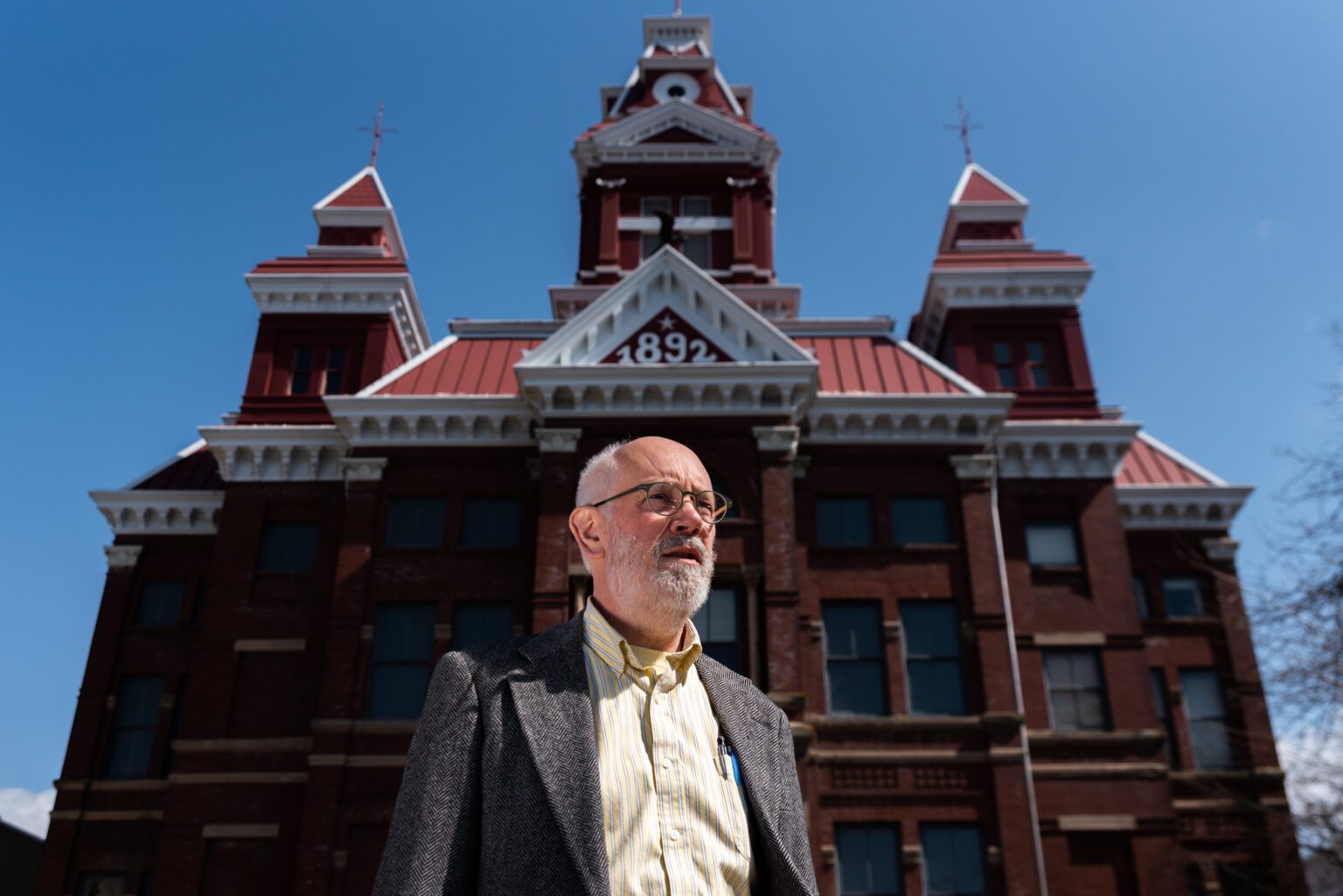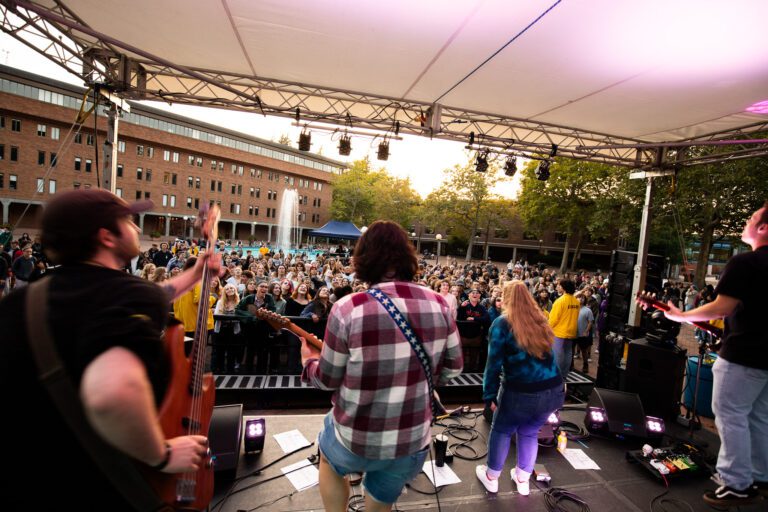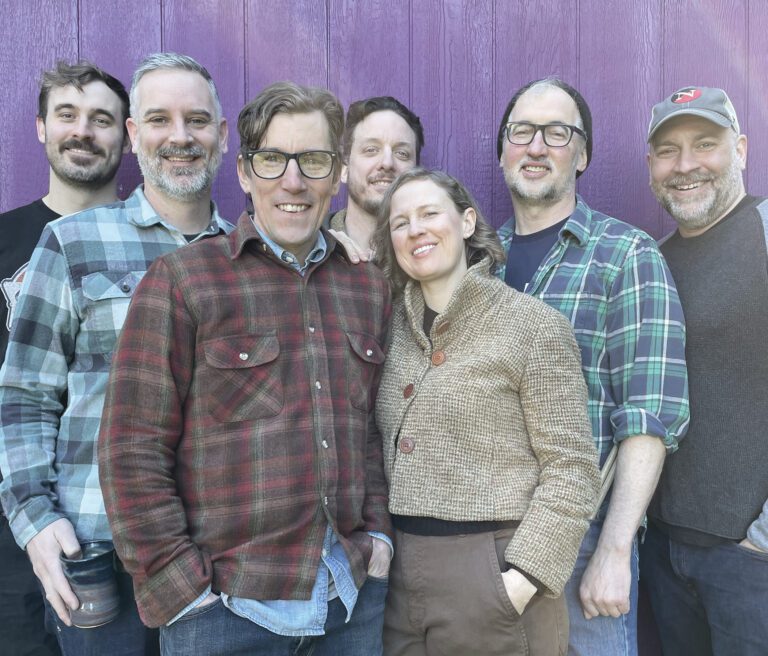Through the tall, thin doors of the Lightcatcher Building’s exhibit room, Whatcom Museum visitors are welcomed by a grid of silk organza fabric squares, all hand-stitched by 20 women to honor the most women sworn in to a single U.S. Congress: 131.
The piece is Cheryl Lawrence’s “Women of the 116th Congress, 2019” — and the pieces that make it up are, in fact, not square, or even the same size.
This factoid cannot be forgotten by the person who installed the display: the person known as “the grid guy,” Paul Brower, the museum’s previous preparator, who retired Feb. 28.
“Big grids like that, they’re usually assigned to me,” Brower said, reflecting on the installation of his final exhibit. “I like doing them, and they’re a challenge.”
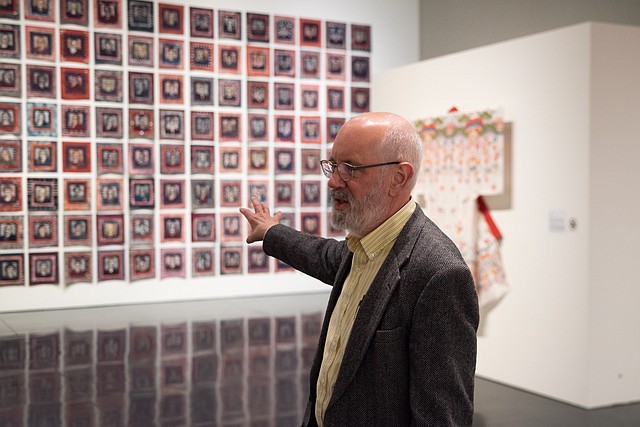
Paul Brower gestures to Cheryl Lawrence’s “Women of the 116th Congress, 2019,” which contains 131 hand-dyed fabric pieces that Brower displayed as a grid on the room’s newly-painted white walls.
(Finn Wendt/Cascadia Daily News)
Brower knew he wanted to retire long before he finally did. A man who had already retired once, from his previous 29-year career at Western Washington University’s art gallery, Brower looked ahead at the museum’s schedule to nail down the perfect time.
He knew he couldn’t miss “Katazome Today: Migrations of a Japanese Art,” an exhibit featuring Japanese textiles, so he planned his departure for just after the installation. He gave six months’ notice and spent part of that time training his replacement.
A preparator is essentially a jack-of-all-trades: They patch and paint walls, hang art, install lights, crate and uncrate art exhibits arriving and departing, maintain interactive exhibits, and probably more.
“I’m an art school dropout,” said Brower, who had enough art credits from the University of Washington, but not enough general requirement credits to graduate.
Eventually, he became a union carpenter. “Art knowledge combined with construction is perfect for museum work,” Brower said. “I didn’t realize it until I started.”
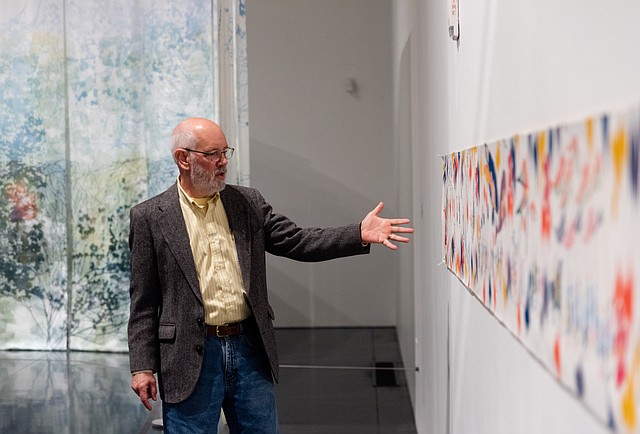
Brower shows off Yuken Teruya’s linen work “Parade From Far Away, 2014,” which is part of the Whatcom Museum’s “Katazome Today: Migrations of a Japanese Art” exhibit. Curated by Amy Chaloupka of the museum and Seiko Atsuta Purdue of Western, Brower said the exhibit is about the traditional work of katazome — a Japanese method of dyeing fabrics using a rice-paste resist through complex stencil designs — and the evolution of it, including its expansion into the U.S.
(Finn Wendt/Cascadia Daily News)
Brower began volunteering at the Tacoma Art Museum, which led to a temporary position there, as well as at The Museum of Flight and the Museum of History and Industry. During that time, he worked at a company building museum exhibits, specifically traveling shows, where he refined his crate-building skills and learned electronic micro wiring.
He was soon recommended for a Smithsonian gig when it came to Seattle, and then a second.
“It’s kind of nice to have Smithsonian on your resume without having to actually live in Washington, D.C.,” Brower said.
Born in New York City, Brower has since lived in Texas, Minnesota and California, but he always returned to Seattle, where his family moved when Brower was 14.
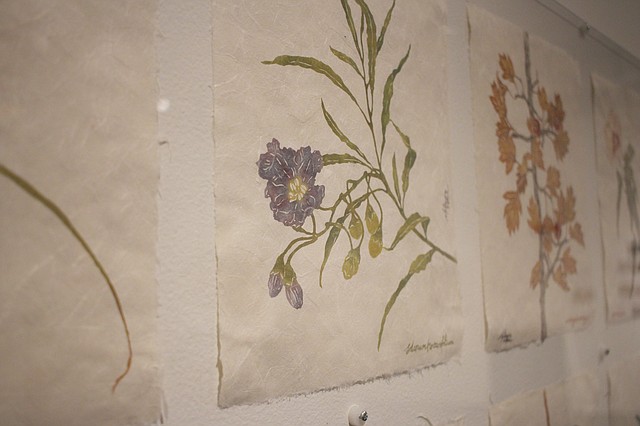
Melinda Heal’s “Beautiful Plants of Canberra, 2022” features 12 katazome-dyed kozo paper portraits of weeds and natural plants. As the preparator, Paul Brower executed artists’ ideas. Heal wanted her work behind plexiglass, and each portrait’s corner has a magnet that attaches to a screw in the wall for display.
(Jaya Flanary/Cascadia Daily News)
In 1989, he took a 50% pay cut (leaving his union and various museum temp jobs) to move to Bellingham for a permanent museum position at the Western Gallery.
“Most museums, someone at my level isn’t normally invited to things like openings,” Brower said. “So when I worked at Western, that all changed, because I was one of only two staff people that had to be there. I may be wearing a sport coat and a tie, right? But I’m also very ready to go grab the mop bucket if somebody spills something.”
It was at the gallery that Brower experienced the most difficult maintenance of a show in his career. At an exhibit of kinetic arts, a piece showing the lifespan of a flower had to be maintained daily. On a wall, 100 test tubes held 100 alstroemeria flowers, and each day Brower had to change out a row.
His brother, fortunately, was a wholesale florist, who made sure a Bellingham retailer had the best-looking alstroemeria flowers, from Peru, twice a week.
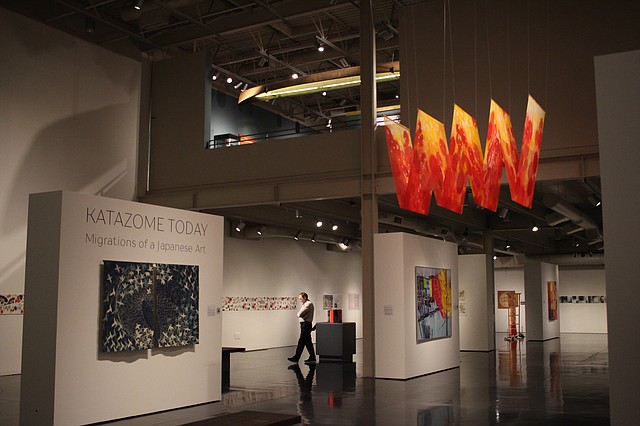
Before displaying the show, Paul Brower and museum staff painted the whole exhibit room — for the first time since the Lightcatcher Building’s opening in 2008 — white, over the previous dark beige. The room’s ceilings are nearly 30 feet tall, allowing for many of the pieces to hang higher than they ever were when previously displayed, including Fumiyo Imafuku’s “Cycle of Time — Music is to rain down from Heaven, 2016,” top right.
(Jaya Flanary/Cascadia Daily News)
When he retired from Western, he missed the students, who he hadn’t expected to work with as much as he did. He picked up on their energy, he said, like when he encouraged them to play their music in his office.
“I learned a lot of bands, a lot of types of music I might not have ever listened to. I never imagined myself listening to hip-hop and enjoying it,” Brower said.
He “retired thinking [he] was going to be retired,” however, five weeks before leaving Western, in 2018, the Whatcom Museum asked Brower if he was interested in a temporary part-time position that quickly became permanent and full time.
He promised the museum two years but stayed for five. Similar to Western, he was invited to exhibit openings at Whatcom and even got some compliments during them from exhibit-goers.
“I like doing the museum work and there was always something in the future schedule, something I wanted to work on,” Brower said.
“Katazome Today” was just one of many.
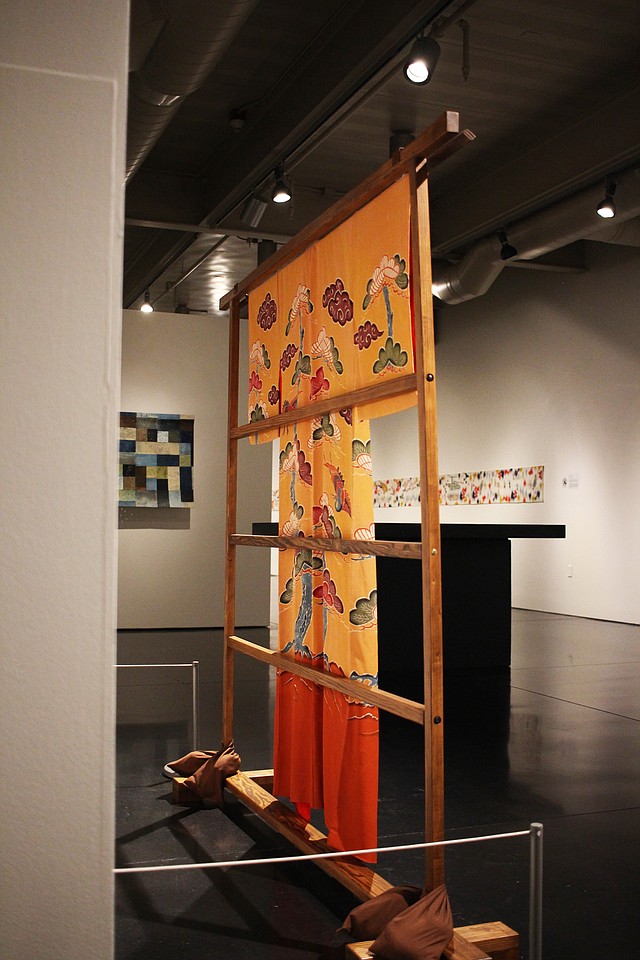
A kimono from the ’60s by an unknown artist is displayed in a traditional way on a stand the museum borrowed from a local collector. Paul Brower used two harsh lights to backlight the piece, allowing visitors to view it from both sides.
(Jaya Flanary/Cascadia Daily News)
Brower said his job could be as easy as hanging a single source-lit framed piece using a wire, and as difficult as getting on the Genie Lift and hanging multiple fabric panels three times before getting them lined up just right.
The exhibit shows until June 11 when it will travel to Boise, Idaho, where a different preparator will display its contents in a different museum, in different ways, for a different audience. Brower expects the katazome show to pack up in three days — though that’s not really his problem, anymore.
“There’s a certain amount of poking fun at me about not being able to stay away,” he said of the first time he visited the museum as a guest since retiring. He loves the museum staff and continues going to lunch with old co-workers.

Yuken Teruya’s “Golden Arch Parkway McDonald’s (Red Yellow),” left, and “Golden Arch Parkway McDonald’s Blue Tree,” right, are hand-cut three-dimensional trees made out of 2005 McDonald’s paper bags. Paul Brower said the pieces are transported in a box in a crate, with a small support piece holding up one side of each bag.
(Jaya Flanary/Cascadia Daily News)
In retirement, Brower and his wife plan to take a short trip each month. He also plans to work on his own art more, including photography, framing and continuing collaborative pieces with his wife, who is also an artist.
Since retiring, he spent three days helping a friend pack up their art collection and is planning a trip to Denver to help another friend disassemble and transport a sculpted piece. He expects to help a lot of friends doing what he does best.
And, of course, Brower plans to continue visiting the Whatcom Museum for future exhibits — ones he had no part in unloading, displaying and packing up.
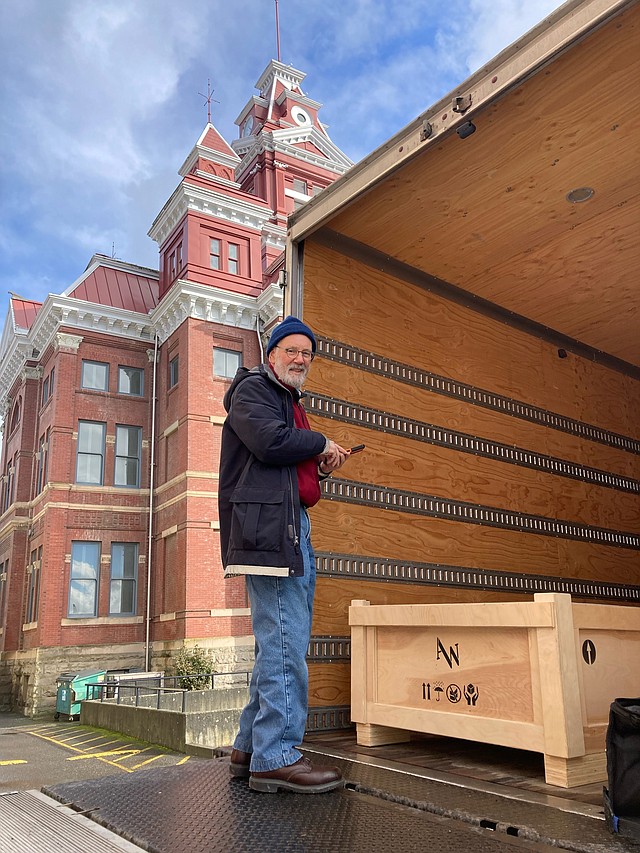
Paul Brower watches a sculpture get packed into a crate on his last day working at the Whatcom Museum outside of the Old City Hall building. Brower learned two tricks about crating art that day, he said, which he “probably won’t ever use since [he’s] retired!”
(Photo courtesy of Whatcom Museum)

